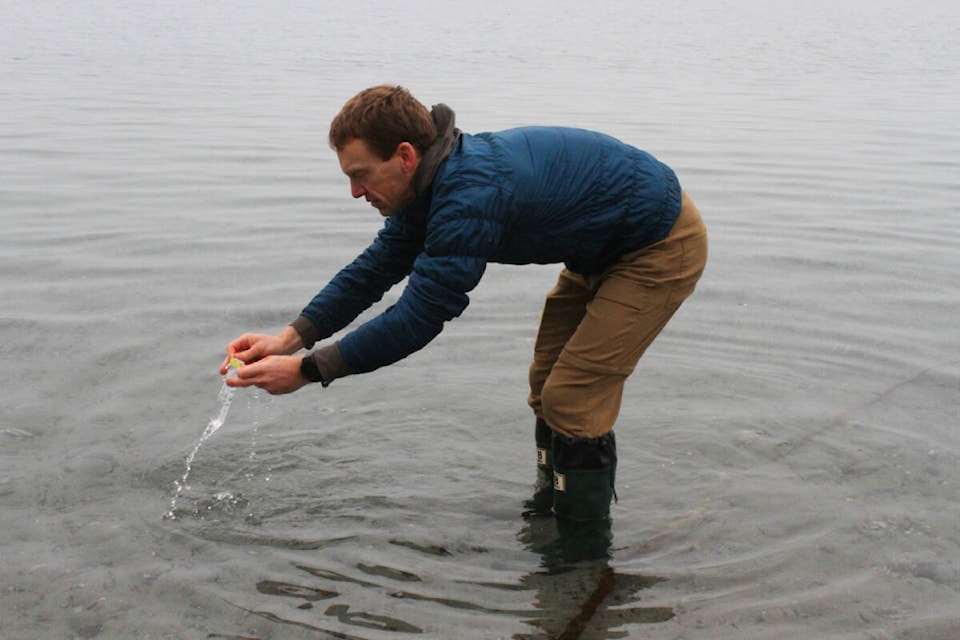Getting your toes wet – physically and metaphorically – is a way many Greater Victorians start the new year.
Still, many residents might not know how much bacteria is in the water before partaking in a polar plunge.
“It’s important to check the water levels and what’s in the water before you have all these people going in,” said Clive Webber, one of the volunteers with the Blue Water Task Force that checks the ocean’s bacteria levels every Sunday.
“The bacteria that we’re checking for, it’s called enterococci. It’s not necessarily that bacteria that can make you sick, but it’s an indicator that the conditions are right for bacteria,” said Webber. “So what we don’t want people to do is, get in the water that’s got too much bacteria for them to get sick. You can get an infection if that bacteria gets inside your mouth.”
Swimmers can also be at risk for a bacterial infection if the contaminated water gets into cuts or ears, according to Webber.
Enterococci can cause urinary tract, wound and soft tissue infections, according to the Canadian government. They’re also associated with bacteremia which can lead to endocarditis in previously damaged cardiac valves. High bacteria levels are only an indicator of a potential infection, but Webber noted that “if they (bacteria) gets inside your body, you can get a certain amount and then they can multiply.”
Before collecting a water sample, Webber checks to make sure it’s not too windy to stay safe. To stay consistent with the test results, he and other volunteers sample the same location every time. Webber usually takes his samples at Willows Beach nearby the Kiwanis Tea Room.
When it’s safe, he heads down to the beach with his cooler bag and then labels the soon-to-be water sample bag with the time, date and location. After sanitizing his hands, he’ll get six inches below the surface and fill the bag with water, avoiding any seaweed. Then he puts the sample in his cooler bag to take it home and places it in the fridge before it gets sampled on a Sunday evening.
He and other volunteers check the water frequently mainly to protect swimmers and other ocean enthusiasts.
“So people are using the water, not just for swimming, but for kayaking, stand-up paddleboarding, even just having their dogs swim in the water,” said Webber. “We want to make sure that people are educated about what the conditions are and what the risks are.”
This past summer the District of Oak Bay put out a warning that swimming at Willows Beach may post a health risk. The water tests done on Aug. 14 along with other dates indicated high levels of bacteria.
READ MORE: High bacteria count closes Oak Bay beach to swimmers
“During the summer when it’s very dry, there are more people using the water, which some people say might raise the results, but we find it’s more correlated to the rain,” said Webber. “So if it’s a rainy day for the next 24 to 48 hours or so if it’s more than three or four millimeters, I think we’re definitely going to see certain places with quite high bacteria levels.” Webber mentioned that any place that has an outlet to drain all the rainwater that has fallen in the neighbouring areas typically has a higher bacteria count.
Considering swimmers were recommended to avoid Willows Beach on multiple occasions, historically the beach tests for very low bacteria levels during the summer.
“We had quite a few high results over the summer, which is unusual considering there isn’t much rain in the summer,” said Webber.
Within the last couple of weeks in December, the results have been good and Webber reports barely seeing any problems. Still, before diving in head-first on New Year’s Day he suggests it’s worthwhile to check the bacteria levels on surfrider.org. On Dec. 31 they will test the water samples and 2024 plungers can look for the results.
